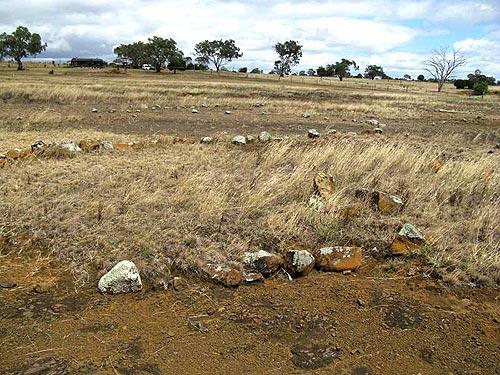Fact Sheet - Gummingurru
In the past, Gummingurru was forbidden to females and uninitiated males. In those days it was a sacred place for male initiation. People came to Gummingurru as they travelled from many parts of southeast Queensland to the Bunya Mountains for the triennial Bunya nut festival. Traditional custodians believe that the figurative symbols outlined by the stone arrangements represent the totems of the various clans that gathered on the site for initiation activities.
Aboriginal initiation ceremonies educate young men and women about their place in society, their relationship with nature and Supernatural Beings (Orucu 2006). Orucu (2006) summarises the main initiation stages common among many Aboriginal groups as follows:
- Segregation of the novices in a special isolated camp or in the bush
- Receiving of instruction from their tutors
- Performance of dances, chants and pantomimes
- Acceptance of the youth into forbidden ceremonies
- Disclosure of sacred objects to the youth
- Cleansing of all traces of the sacred world so the newly initiated can return to the ordinary world
Another characteristic of Aboriginal male initiation rites is the preparation and symbolism of the ritual death of the novice’s childhood life and role followed by his rebirth as a spiritual being with a new stage of consciousness and a new adult role in the community (Orucu 2006). Signs of this death ritual include certain trials and conduct (such as remaining silent) during the segregation period and bodily surgery such the cutting of scars into the skin.
In some cases, the killing of novice is symbolically acted out as a swallowing by a gigantic monstrous Being, usually a snake (Mircea as cited in Orucu 2006). Initiation rites in Gummingurru follow this pattern. Among the stone motifs is a large carpet snake with an accentuated belly, which was the place from which the boys emerge symbolically as men (Ross 2008).
 |
| Can you see the carpet snake motif? |
Traditional custodian of Gummingurru, Brian Tobane, described male initiation as akin to a present day apprenticeship for the young males. He said "... they had to get their markings or scarring done on the site and then they could choose to be a weapon maker, local doctor, story teller or a hunter." He also explained that the markings indicate that a man can now eat certain restricted food and attend secret activities (Condamin Alliance 2008).
References
- Condamine Alliance 2008, Drum-beat of progress sounds for ancient site, viewed 25 April 2009, http://www.regionalnrm.qld.gov.au/about_new/news_events_publications/news/vor/2008_july/condamine_ancient.html.
- Orucu, G 2006, 'Initiation Rites of Aboriginal People', New Acropolis, viewed 25 April 2009, http://www.acropolis.org.au/articles/InitiationRitesAborigines_GunerOrucu.pdf.
- Ross, A 2008, 'Managing meaning at an ancient site in the 21st Century: the Gummingurru Aboriginal stone arrangement on the Darling Downs, Southern Queensland', Oceania, vol. 78, pp. 91-108.
